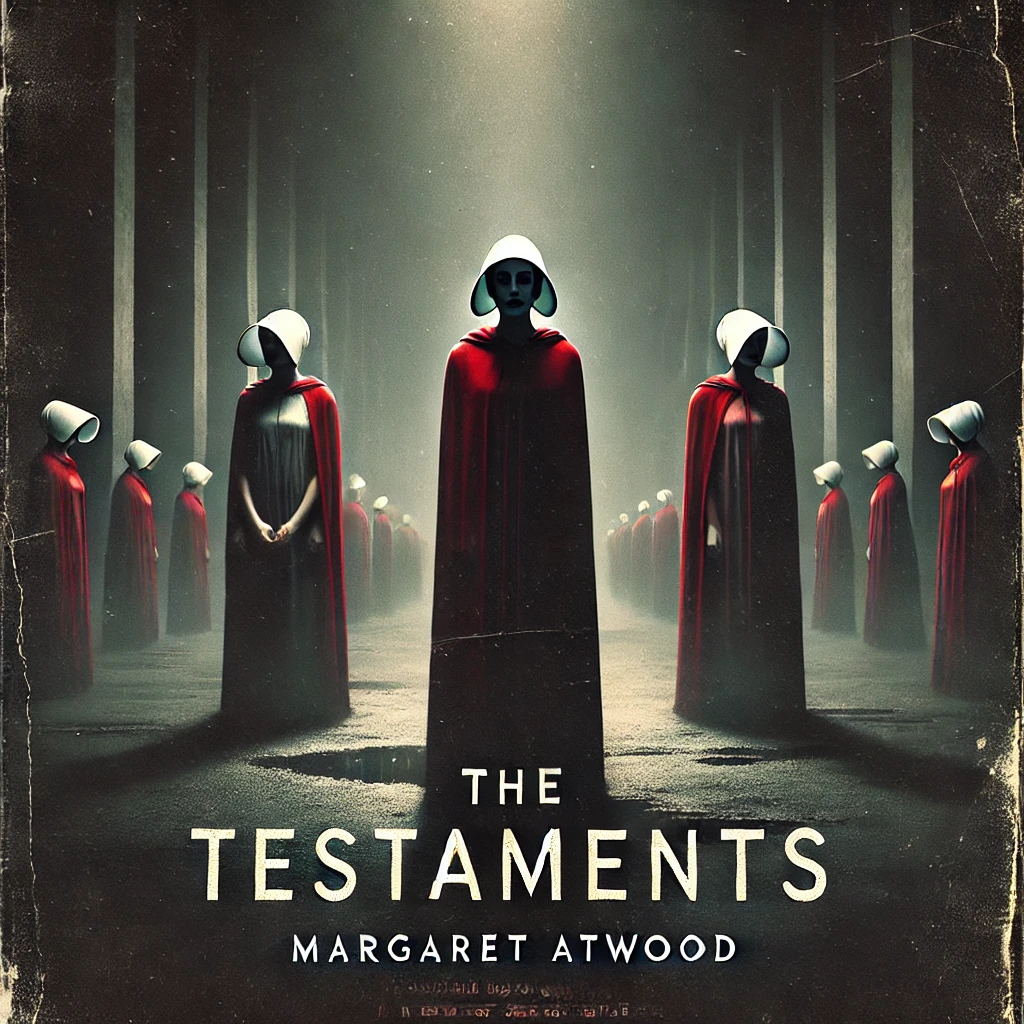The Testaments, published in September 2019, is a monumental sequel to Margaret Atwood’s critically acclaimed novel, The Handmaid’s Tale. The release of this much-anticipated sequel was met with tremendous excitement and curiosity, reflecting the profound impact its predecessor had on readers and critics alike. The original novel, which has been a cornerstone in contemporary literature, set a high bar, and The Testaments lived up to the expectations with finesse.
Expanding on the dystopian universe of Gilead, The Testaments is set fifteen years after the events of The Handmaid’s Tale. It delves deeper into the societal structures and personal lives of its characters, offering a multifaceted narrative that showcases Atwood’s exceptional storytelling prowess. The novel explores the experiences and perspectives of three distinct female protagonists, providing a rich, layered insight into the workings of Gilead.
The critical reception of The Testaments has been overwhelmingly positive. It not only satisfied long-time fans but also garnered the recognition of prestigious literary circles. Notably, it was awarded the 2019 Booker Prize, an honor it shared with Bernardine Evaristo’s Girl, Woman, Other, marking a significant milestone in Atwood’s illustrious career. The novel’s acclaim is also reflected in its numerous nominations across various awards, cementing its status as a worthy successor to The Handmaid’s Tale.
The anticipation surrounding the release of The Testaments was palpable. Readers, having been captivated by the themes of power, control, and resistance in The Handmaid’s Tale, were eager to return to the unsettling yet enthralling world Atwood had created. The Testaments not only revisits this world but expands it, providing a fresh yet familiar exploration that continues to provoke thought and evoke strong emotions. This sequel stands as a testament to Atwood’s enduring relevance and her unparalleled ability to capture and challenge the human condition through literature.
Recap of ‘The Handmaid’s Tale’
‘The Handmaid’s Tale’ by Margaret Atwood is set in the dystopian society of Gilead, a totalitarian regime that has overthrown the United States government. In Gilead, extreme theocratic laws dictate every aspect of life, particularly focusing on the subjugation and control of women. The society is organized by rigid hierarchies, and fertility is commodified due to plummeting birth rates.
The narrative centers on the character of Offred, one of the Handmaids whose sole purpose is to bear children for Gilead’s elite Commanders and their Wives. Handmaids are stripped of their identities, forced into servitude, and are named after the Commander they serve—in Offred’s case, “Of Fred.” Offred’s story is one of survival and resistance as she navigates this oppressive world, haunted by memories of her past life and separated from her husband and daughter.
Significant themes in ‘The Handmaid’s Tale’ include the loss of identity, the power dynamics inherent in gender and class, and the extent to which personal freedom can be curtailed by authoritarian rule. The novel elucidates the dangers of extremism and the impacts of a society that devalues women’s autonomy. Offred’s clandestine relationship with Commander Fred, her forbidden connection with Nick the chauffeur, and her involvement with an underground resistance movement called Mayday, add layers of complexity to her experience.
Key characters such as Serena Joy, the Commander’s Wife, and Aunt Lydia, one of the enforcers of Gilead’s doctrines, highlight the different roles women adopt in perpetuating and resisting the regime. Offred’s plight and tentative acts of rebellion set the stage for ‘The Testaments,’ offering readers essential context about the world and struggles that define Gilead.
Setting the Stage: Life in Gilead
The dystopian society of Gilead, originally depicted in ‘The Handmaid’s Tale,’ continues to be a vivid and oppressive backdrop in ‘The Testaments.’ Gilead remains a theocratic regime, deeply entrenched in rigid patriarchal norms. The society is governed by an authoritarian leadership that imposes strict control over the populace, particularly targeting women’s freedom and agency. Women’s roles are distinctly compartmentalized into categories such as Wives, Handmaids, Marthas, and Aunts, each with its own prescribed set of limitations and duties.
Despite the oppressive continuity, ‘The Testaments’ illustrates subtle shifts within Gilead’s societal structure. The veneer of unwavering control begins to show cracks, as underground resistance movements grow more coordinated and influential. This burgeoning insubordination signifies a simmering discontent among the inhabitants, suggesting potential vulnerabilities in an otherwise monolithic regime.
Social norms in Gilead continue to prioritize reproduction, with Handmaids still bearing the primary responsibility of childbirth. However, the sequel introduces a deeper perspective on the roles of Aunts. These women, who were previously seen primarily as enforcers of the regime’s draconian laws, are now depicted with more complexity, revealing internal hierarchies and power dynamics that shed light on their delicate balancing act within Gilead’s strict structure.
Women’s lives in Gilead remain defined by rigid codes of behavior and severe punishments for transgressions. Yet, ‘The Testaments’ also showcases acts of quiet rebellion and solidarity among women, reflecting a collective yearning for freedom and equality. The interplay between the facade of order and the underlying currents of dissent sets the stage for the novel’s exploration of power, control, and resistance.
These nuanced depictions of continuity and change within Gilead are crucial for understanding the challenges and dynamics faced by the characters in ‘The Testaments.’ They provide a rich context where personal struggles intersect with broader themes of oppression and liberation, making the sequel a compelling continuation of Gilead’s unsettling narrative.
Introduction of the Three Protagonists
Margaret Atwood’s “The Testaments” brings to life the intertwined stories of three compelling female protagonists: Aunt Lydia, Agnes, and Daisy. Their distinct yet interconnected narratives offer multifaceted perspectives on the dark, dystopian world of Gilead, a society wrought with oppressive hierarchies and rigid gender roles. Through these three characters, Atwood masterfully explores the complexities and nuances of resistance in a totalitarian regime.
Aunt Lydia, one of the most prominent figures in Gilead, emerges as a complex and multi-dimensional character in “The Testaments.” Far from being a mere villain, she embodies the ambiguity of survival under extreme oppression. Aunt Lydia’s backstory reveals the pragmatism and strategic thinking she employs to navigate and manipulate the system from within. Her narrative provides critical insights into the administration of Gilead and its undercurrents of power and control.
Agnes is introduced as a young girl raised within the confines of Gilead’s theocratic society. Her life epitomizes the indoctrination and subjugation of women, as she is groomed to fulfill the roles designated by the regime. As Agnes grapples with her predetermined path, she becomes increasingly aware of the discrepancies and injustices around her. Her journey towards self-awareness and rebellion is compelling, shedding light on the internal conflicts faced by those born into oppressive systems.
Daisy, on the other hand, offers an external perspective as a girl living in Canada, who becomes intricately involved in the resistance movement against Gilead. Her story underscores the broader geopolitical tensions and the international ramifications of Gilead’s existence. When Daisy discovers her true identity and her connectedness to Agnes and Aunt Lydia, her narrative underscores the themes of identity, agency, and resistance.
The convergence of these three perspectives enriches the narrative tapestry of “The Testaments.” By presenting the viewpoints of an enforcer, a victim, and a resister, Atwood provides a comprehensive exploration of Gilead’s oppressive regime and the varied forms of defiance it incites. The multi-narrative structure deepens the reader’s understanding of the resilience and strength of women in the face of tyranny, making “The Testaments” a nuanced and powerful companion to “The Handmaid’s Tale.”
Aunt Lydia: A Complex Character
One of the focal points in “The Testaments” is the character of Aunt Lydia, whose layered persona adds intricate depth to the narrative. Initially portrayed in “The Handmaid’s Tale” as the stern and unyielding enforcer of Gilead’s despotic rules, Aunt Lydia undergoes a significant transformation in this sequel. “The Testaments” dives into her backstory, revealing the complexities behind her austere exterior. Her motivations are uncovered through a series of journal entries, disclosing a woman who is both a victim and a perpetrator, navigating the treacherous terrain of survival within a totalitarian regime.
Exploring Aunt Lydia’s backstory, we learn that she was once a judge, embodying virtues of justice and fairness. Her conscription into Gilead’s hierarchy was not entirely voluntary but rather a coerced adaptation to avoid a more harrowing fate. This compulsion introduces a layer of sympathy, showcasing her as a character compelled to wield power as a means of self-preservation. Her evolution is marked by internal conflicts, as she grapples with the harsh realities of her role in perpetuating Gilead’s repressive system.
The power dynamics within Gilead are starkly evident through Aunt Lydia’s interactions with other characters. Her strategic acumen, manipulation skills, and ability to maintain authority highlight her as a pivotal figure within the regime. However, these same attributes also underscore her ultimate goal: the dismantling of Gilead from within. This duality—her outward allegiance to Gilead and a covert rebellion against it—reveals a deeply conflicted character whose actions are often driven by pragmatic survival instincts rather than ideological alignment.
Aunt Lydia’s multifaceted character exemplifies the theme of survival in oppressive regimes. Her journey from a former judge to a high-ranking enforcer in Gilead, and ultimately to a subversive element within the same system, enriches the narrative. By depicting her intricate motivations, internal struggles, and strategic maneuvers, Margaret Atwood illuminates the complexities of human behavior under duress. Aunt Lydia’s character not only adds depth to the storyline but also serves as a stark reminder of the moral ambiguities and resilience necessary for survival in an authoritarian society.
Agnes: Growing Up in Gilead
Agnes Jemima, one of the central characters in Margaret Atwood’s “The Testaments,” provides a poignant lens through which readers can view the oppressive nature of Gilead’s society. Born as a Commander’s daughter, Agnes’s early life is marked by the stringent indoctrination typical in Gilead’s theocracy. From a tender age, she is taught to embody the rigid virtues espoused by the regime, including modesty, submission, and piety, all designed to maintain her as a model citizen and future wife.
Gilead’s oppressive confines become more pronounced as Agnes grows older. Her education is less about critical thinking and more about enforcing traditional gender roles. Her curriculum includes lessons on domestic duties, Bible studies, and the history of theocratic doctrines, all designed to suppress her intellectual curiosity and ensure compliance. These early years cultivate a sense of duality within Agnes; she struggles with the contrasting teachings of Gilead and her own burgeoning sense of self-awareness.
As Agnes transitions from girlhood to womanhood, she encounters several pivotal experiences that shatter her illusions about the society she has been conditioned to revere. Witnessing injustice and cruelty, such as the stoning of dissenters and the subhuman treatment of “unwomen,” fosters a critical awakening. Agnes’s growing disillusionment challenges her previously unshakable beliefs and compels her to question the moral fabric of Gilead.
Character development is central to Agnes’s narrative arc. Initially, a paragon of Gileadean virtue, she gradually evolves into a figure of resistance. This transformation is facilitated by her interactions with other key characters and pivotal events that expose her to suppressed truths. As she becomes more allied with dissenting factions, Agnes’s role within the broader plot intensifies, positioning her as a crucial participant in the eventual upheaval against Gilead’s totalitarian regime.
Agnes’s journey in “The Testaments” encapsulates the struggle for personal autonomy within an oppressive society. Her story is a testament to the resilience of the human spirit and the enduring quest for freedom and truth, even in the most repressive of environments.
Daisy: The Outsider’s Perspective
Daisy’s life begins far from the oppressive and dystopian world of Gilead. Growing up in Canada, she enjoys the relative freedoms and privileges of a society untouched by the totalitarian regime. Her mundane existence involves commonplace challenges faced by many young adults—attending school, navigating friendships, and rebelling against parental authority. Daisy’s life, though unremarkable by many standards, represents a stark contrast to the stringent and brutal conditions within Gilead.
However, Daisy’s seemingly ordinary life is abruptly disrupted when she learns of her true origins and the imminent dangers linked to her past. This revelation acts as a catalyst, propelling her into the harsh realities of Gilead—an environment that is foreign and terrifying in equal measure. Her immersion into this starkly different world comes with significant shock as she witnesses the severity of Gilead’s socio-political landscape. The stark contrast between her familiar, freer society and the authoritarian theocracy of Gilead forces Daisy to reevaluate her perceptions and convictions, intensifying her journey of self-discovery.
As Daisy becomes entangled with Agnes and Aunt Lydia, the narrative delves deeper into her evolving perceptions of Gilead. Agnes, who has been raised within the strict confines of Gilead, represents the indoctrinated citizen, while Aunt Lydia embodies the enforcer of its rigid doctrines. Daisy’s interaction with Agnes highlights the cultural and ideological chasm between individuals raised in completely disparate societies. Through Aunt Lydia, Daisy confronts the moral complexities that underlie the authority figures in Gilead, unveiling a nuanced understanding of power and resistance.
Daisy’s unique perspective, shaped by her upbringing in a freer society, brings an outsider’s critical viewpoint to the narrative. Her fresh insights and stark reactions underscore the oppressive nature of Gilead as seen from the lens of someone whose baseline for normalcy is vastly different. This outsider’s perspective is pivotal in challenging and deconstructing the normalized horrors experienced by Gilead’s residents, offering readers a poignant commentary on freedom, oppression, and the human spirit’s resilience.
Themes and Final Thoughts
Margaret Atwood’s “The Testaments” delves deeply into several compelling and timely themes, including power, resistance, identity, and the role of women in society. These themes are intricately woven into the narrative, primarily through the experiences and perspectives of the three protagonists: Aunt Lydia, Agnes, and Daisy.
Power is a central theme in “The Testaments,” explored through the totalitarian regime of Gilead. Aunt Lydia’s position within this regime demonstrates the complexities of power dynamics. Once a women’s rights advocate, Aunt Lydia now navigates the dangerous political landscape, balancing survival and subtle resistance. Her character provides a nuanced view of power, showing how it can corrupt but also be subverted from within.
Resistance is vividly illustrated by each protagonist in unique ways. Agnes’ journey from a believer of Gilead’s doctrines to a critical thinker and Daisy’s involvement in the Mayday resistance highlight different facets of defiance. Their actions represent the diverse approaches to challenging oppression, emphasizing that resistance can take many forms, from internal doubts to overt actions.
Identity is another significant theme, with each protagonist grappling with their sense of self. Agnes strives to understand her heritage and true self amidst Gilead’s repressive norms. Daisy, raised outside Gilead, seeks to reconcile her identity with her origins. Aunt Lydia’s reflections on her past life offer a poignant contrast to her current role, underscoring the fluidity and resilience of personal identity amidst turmoil.
The role of women in society is critically examined throughout “The Testaments.” Atwood crafts a narrative that showcases the varied experiences of women within Gilead’s patriarchal system, from subjugation to rebellion. This theme resonates powerfully today, reflecting ongoing global conversations about gender equality and women’s rights.
Overall, Atwood’s skillful weaving of these themes into the story not only enriches the narrative but also underscores its continued relevance. “The Testaments” stands as a vital exploration of contemporary issues and a worthy addition to Atwood’s literary canon, providing both reflective insights and a compelling continuation of the world introduced in “The Handmaid’s Tale.”



